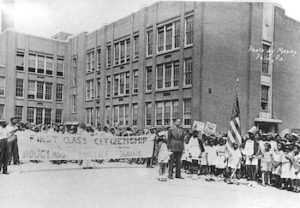
Arthur-Huff-Fauset-with-children, Philadelphia
*Arthur Fauset was born on this date in 1899. He was a Black activist, anthropologist, folklorist, and educator.
Born in Flemington, New Jersey, Arthur Huff Fauset grew up in Philadelphia. He was the middle child of three children in an interracial family. His father, Redmon Fauset, was a Black African minister in the African Methodist Episcopal Church, and his white wife, Bella, was Jewish-American. Bringing three children from her first marriage, she converted to Christianity to marry Fauset. Redmon Fauset had seven children from his first marriage before his wife Annie (née Seamon) died.
Both Redmon and Bella Fauset were dedicated to the importance of education. Redmon believed that writing was an essential discipline, while Bella was a devout integrationist, believing firmly in social integration. She encouraged the children in their schooling after Redmon died when Arthur was four. In his adult life, in contrast to his father, Fauset broke away from religion and identified as a "free thinker."
He attended Central High School, a top academic high school for boys in Philadelphia. He studied further at the Philadelphia School of Pedagogy for Men, where he received his teaching credentials and started his first teaching position in 1918. In the mid-1920s, he took the principal's merit exams and was selected as head of the John Singerly School, serving for 20 years until 1946. During this period, Fauset also began studying and practicing anthropology. He was mentored by writer Alain Locke, who also became a friend and emphasized an academic approach to guide his activism. He earned a B.A. in 1921 and an M.A. in 1924 from the University of Pennsylvania. After teaching for years and pursuing advanced studies, he earned a PhD. in 1942 from Penn. Fauset pursued an education to feed and develop his intellect. He was discouraged because of his race from ambitions to teach at the university level. Non-whites had fewer opportunities in academia, but some men completed advanced degrees and obtained some college positions.
He was interested in folklore and conducted fieldwork in the South, the Caribbean, and Nova Scotia to learn these tales. During the Harlem Renaissance, he also made large contributions to bringing awareness to African American folklore through tales, songs, problems, and jokes. Faust was also known for letting Black voices speak for themselves, telling them the way that they were told to him rather than imposing his voice and theories on them. This approach resulted in many people appreciating his writing. His first piece appeared in The Crisis while he was a college student at the University of Pennsylvania with his short story "The Tale of The North Carolina Woods" in January 1922. He aimed to cultivate and revive Black culture in America through these tales and reestablish a sense of pride that had long been abandoned.
Fauset input his theories and ideas about these stories in his first book, Folklore from Nova Scotia, published in 1931. In this book, Fauset examines Black folklore through the diffusion model, which looks at how information spreads throughout a population. He wrote about how African American folklore had changed over time, especially how it integrated folklore from other cultures (such as Irish or French).
Fauset believed this was not because Negroes had assimilated into the dominant culture of their province but because they had integrated aspects of the dominant culture by contributing to the dominant culture. During his time in Nova Scotia in the summer of 1923, Fauset found that hardly any of the traditional stories told by Negroes in the United States were told in Nova Scotia, and the stories told in Nova Scotia were unheard of in the United States. It was as though each group only had small pieces of a larger puzzle and needed help organizing and bringing all of their stories together to understand their whole culture better. Here Fauset tied together and spread these stories to better educate all Negroes of their heritage. He used these stories to discredit stereotypes of African Americans. For example, many Negroes in Nova Scotia told him they would go down to visit the states if the weather was not as hot there. This debunked the stereotype that all Negroes enjoyed and were drawn to warmer climates, giving them a more authentic identity when portrayed as minstrels in the United States.
After 1946, he traveled abroad, spending time in Europe and Egypt. He lived for a year in Mexico, an experience that prepared him to educate Spanish speakers later. He lived in New York City beginning in the 1950s. In the era of McCarthyism and the HUAAC, his association with the NNC and the United Peoples' Action Committee (also considered radical for the time) led to his being expelled from the New York Public School system in 1960. He continued to teach in New York, his home base, into the 1960s and 1970s. However, he did not hold any long-term positions. It was during this period that he taught English at the Spanish American Institute. He also founded a school designed to teach English and business basics to Spanish speakers. Insufficiently funded, the school did not last long. Arthur Fauset died on September 2, 1983.
Image: John Mosley Collection,
Courtesy, Charles L.-Blockson Afro-American Collection Temple University